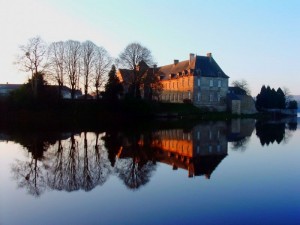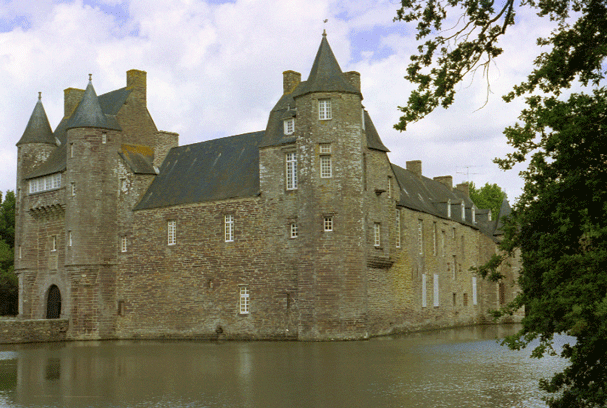
The medieval Chateau de Trécesson, still privately owned and in magnificent condition, at least if seen from the outside: we’ve never had the privilege of going in.
In the interior of Brittany, the peninsula that is the westernmost part of mainland France, France’s Cornwall if you will, is la Brocéliande, the magic land of Merlin and, if you believe the local residents, King Arthur’s Round Table. This mythic brotherhood, the original Camelot, is located somewhere in the southwest of England or somewhere here in Brittany, depending on who is doing the telling. Merlin’s grave can be found here, or so they say, and we left a bottle of wine there once, a small tribute to the myth if not the man.
Collections of stones called menhirs that pre-date Christianity dot the countryside, an assortment of smaller and apparently less organized stonehenges, and the land here feels genuinely ancient. There are as many pagan sites as Christian.
On a dark night on the side of the road in the forest of Brocéliande, where I once slept in the little Ford van conversion with a young Nick and very young Tom, the very stillness and silence were disturbing. I couldn’t sleep for most of that night.
The chateau de Trécesson (in the top photo) is off the beaten track, and although it is signposted, we may not have found it if Grand-père had not shown us the way. Local lore has several ghosts sharing the chateau with its living occupants. The best known is “la dame blanche de Trécesson,” the white lady of Trécesson. She is reputed to have been buried alive on the morning of her wedding day in the 18th century. A hunter watched the crime occur, but by the time he could uncover her, working frantically, she was already dead. She has haunted the chateau ever since. As I said, there is something disturbing here.
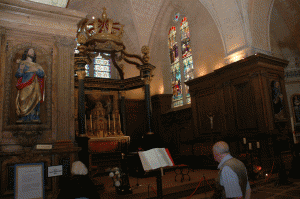
The interior of the abbaye is extraordinary, as you may catch a glimpse of here, with the altar framed in ornate polished wood. Tante Lucette and grand-père are admiring the sights. A little later, poor tante Lucette tripped and hurt herself.
The Abbaye de Paimpont is not far from the Chateau, and equally impressive in an austere and almost foreboding way: perhaps I simply mean equally medieval. The Abbaye was founded in the 6th or 7th century, destroyed by the Vikings (called the Normans locally) in the 11th century, and rebuilt and modified periodically thereafter. Its site is on a lake across from a pagan place of worship, perhaps co-opted by the early monks.
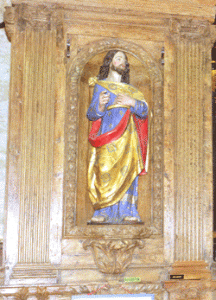
A close up of the wooden statue of St Augustine in the Abbaye de Paimpont. It was being refurbished when we visited during the summer of 2004.
Amidst these splendid and powerful edifices is one which attracts me even more. A tiny little chapel, la Chapelle de Saint-Jean de Jérusalem, is buried in the woods off the beaten track in the forest of Paimpont. As its name suggests, it was founded by the knights templar or their “hospitalier” (or charitable) cousins. It has stood for close to a thousand years, and it would fit on the ground floor of our home.

The grey, not black, cat who warily welcomed us to the Chapelle de Saint-Jean de Jérusalem in August 2004.
Just as Marlow has Bisham Abbey, a small and impossibly old abbey where knights templar worshipped and are buried, so Brocéliande has a small and impossibly old chapel where they lived and worked.
There is an inescapable kinship here. Just as Marlow is home for the Stocks, Brocéliande is home for the Berhauts, Marie-Hélène’s family. La Grée, grand-père’s cottage where we share the local summer’s tranquility, is just on the edge of la Brocéliande.
The kinship is in the shared history, reassuring certainly, but also at times it feels more than a little sombre. Brocéliande is the real thing.
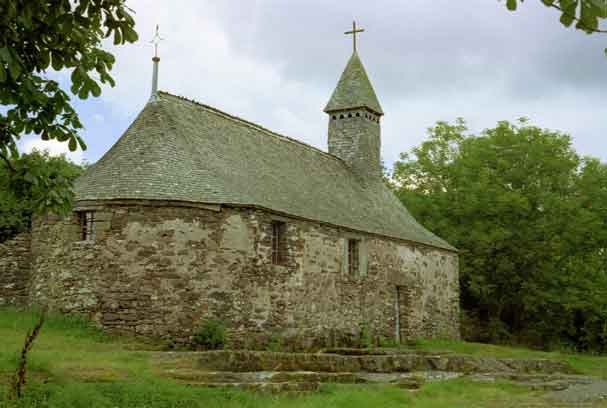
The Chapelle de Saint-Jean de Jérusalem, sitting modestly on the granite, buried in the forest, as it has sat for a millenium.


